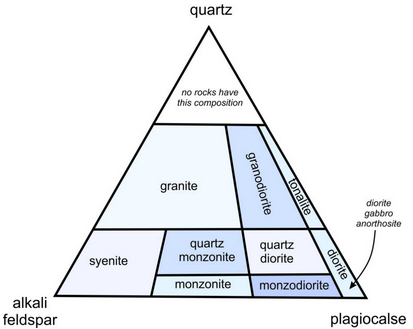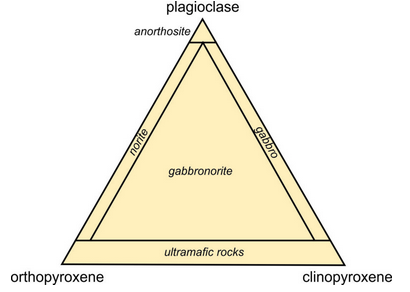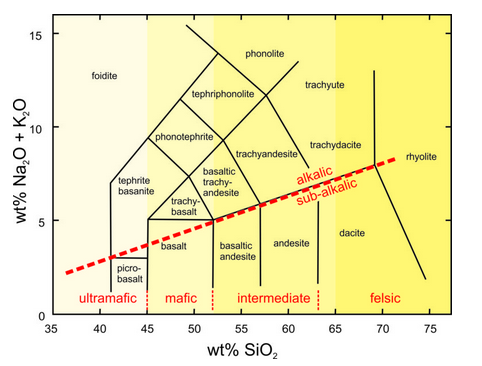6.5: Naming Igneous Rocks
- Page ID
- 18942

Most igneous rocks contain feldspar or quartz. So, the most widely used and relatively straightforward classification scheme for igneous rocks is based on the relative amounts of quartz, plagioclase, and alkali feldspar that are present. It is the International Union of Geological Sciences (IUGS) system. Figure 6.98 shows a version for normal plutonic rocks. Other minerals may be present, but using this system, only the ratios of quartz, plagioclase, and alkali feldspar determine the rock name. As an example, we call a rock that contains nearly equal amounts of quartz and plagioclase, and that contains no or very little alkali feldspar, tonalite.
This IUGS system works well for many plutonic igneous rocks, and we can often identify quartz, plagioclase, and alkali feldspar in the field – so it is very convenient. It does not work well for rocks that do not contain significant amounts of quartz or feldspar, and it makes no distinction between rock types that contain similar amounts of quartz, alkali feldspar, and plagioclase but vary significantly with respect to other minerals. For example, gabbro, diorite, and anorthosite all contain plagioclase, with very minor alkali feldspar and quartz, if any. They plot in the bottom right corner of the triangle and consequently cannot be distinguished.

The main difference between gabbro and diorite is that gabbro, which is a mafic rock, contains calcium-rich plagioclase. Diorite, is more silicic than gabbro, and contains more sodic plagioclase. The standard IUGS system takes no account of feldspar composition, so this distinction is lost. Gabbro and anorthosite are closely related and compositions between are common. But, anorthosite is almost entirely plagioclase, and gabbro contains significant amounts of clinopyroxene in addition to plagioclase. The IUGS has developed a separate triangular diagram for gabbro and related rocks, it is shown here in Figure 6.99.
Magmas poor in SiO2 but rich in alkalis will yield rocks containing nepheline or leucite (both members of the feldspathoid group) instead of feldspars. Similarly, ultramafic rocks, that often contain no quartz or feldspars are not represented on the standard IUGS diagram. So, the IUGS has developed different triangular diagrams for these kinds of rocks.

The diagram in Figure 6.98 is for plutonic rocks. The IUGS has a similar system for volcanic rocks, but volcanic rocks may be very fine grained, making mineral identification difficult or impossible, and they may contain significant amounts of volcanic glass in lieu of minerals. So, instead of naming volcanic rocks based on mineralogy, petrologists often assign names based on alkali and silica content. This is the total-alkali-silica system (TAS), shown in Figure 6.100. The diagonal red line divides rocks into those that we call alkalic (above the line) and sub-alkalic (below the line). The most common volcanic rocks are sub-alkalic, ranging in composition from basalt (mafic) to rhyolite (silicic).


